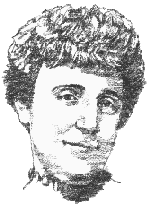The original novel: 'A Little Princess'


Frances Hodgson Burnett was born Frances
Eliza Hodgson in a small village near Manchester on November the 24th in 1849.
Her family was not too wealthy before but the father died in 1853 and the
family, stricken with poverty, had to live in the slums of Manchester. Burnett
soon discovered her love for making up stories and writing them down to escape
the unfriendly reality but it was after the move to America, Tennesse in 1865
 when she actually published some of her stories in American magazines to
support her family. She became famous long after her marriage with Dr Swan
Burnett in 1873 due to the tremendous success of her first novel,
'Little Lord Fauntleroy' which was published in 1886. Frances
Hodgson Burnett died on the 29th October in 1924.
when she actually published some of her stories in American magazines to
support her family. She became famous long after her marriage with Dr Swan
Burnett in 1873 due to the tremendous success of her first novel,
'Little Lord Fauntleroy' which was published in 1886. Frances
Hodgson Burnett died on the 29th October in 1924.
Three of Burnett's works have reached the status of all-time classics of children's literature:
The story of Sara Crewe first appeared in serialized form in the Saint Nicholas magazine and was titled 'Sara Crewe'. It was very successful and the readers were hoping for an extended version. Burnett, too, came to the conclusion that there has happened more behind that brick walls of the Seminary which was not covered by 'Sara Crewe' yet. And so in 1903 an also very successful theater play came into life. It was titled 'A Little Princess' and in it, many of the characters which are now a important part of the story were introduced. Characters like the scullery-maid Becky, Sara's friends Ermengarde and Lottie as well as the rat Melchisedec. In 1905 the novel 'A Little Princess' was published and it has not lost its charm until today.
Frances Hodgson Burnett was remembering her very own childhood memories when she wrote 'A Little Princess'. Just imagine how hard the life for Burnett's family must have been after the death of the father. For children it was a cold and unfriendly world but children have got a special talent to get over a hard time. Although reality forces them to do reasonable things, they can still keep their lively imagination. Just like her heroine Sara, Burnett used her imagination to distract herself from misery.

80 Years after the release of the novel in 1985, the story became part of
Nippon Animation's World Masterpiece Theater line. 'A Little
Princess Sara' was shown in 46 episodes on Fuji TV one episode a week.
The step from the novel to the animated series is somewhat similar to the
step from 'Sara Crewe' to 'A Little Princess'.
The series again tells more about the happenings at the Seminary than the
novel did. The novel is held in a relatively descriptive style which focuses
more on Sara's thoughts and feelings than on a continuous storyline. The
screenplay-section tells you how the series deals
with the problem to embed the key scenes from the novel well into the plot and
how it combines them with some new events and characters.
In the novel Sara mainly confronts other people with things she has made up
in her mind with sometimes fascinating results, but the series is a bit
different here. Visit the character guide
to get more information.
The anime is not the only screen adaption of the story. There are several films, some for TV, some for the big screen and a TV series. The last film was released just recently in 1995.
You can read both 'Sara Crewe' and 'A Little Princess' online via FTP. Project Gutenberg is a non-profit organization which strives to put classic literature online. Here are the links:
There is a more structured version of 'A Little Princess' at the University of Maryland.